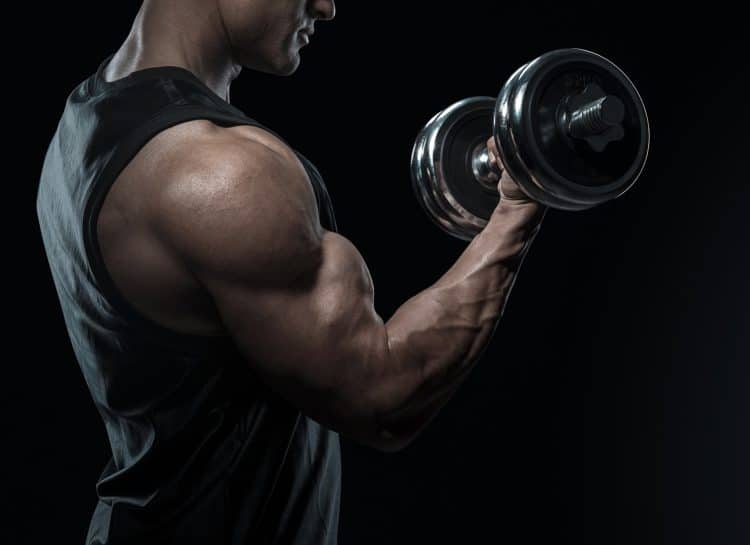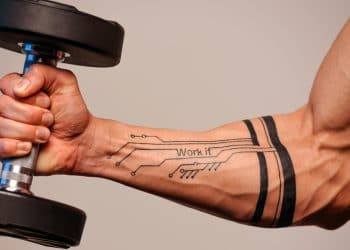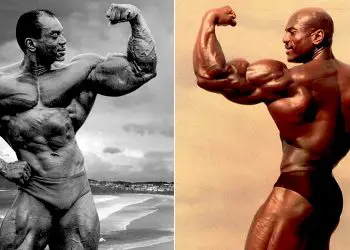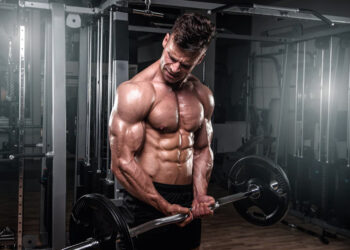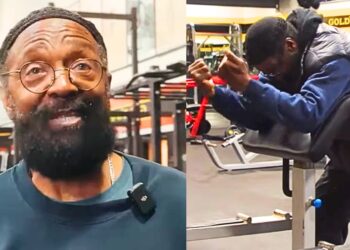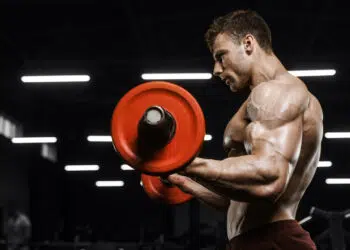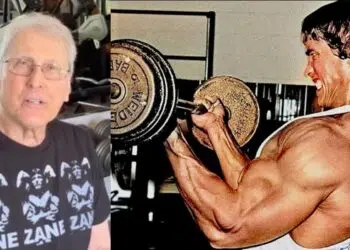In the majority of cases, the best way to do any exercise is with a controlled tempo and perfect form. This keeps the tension on your muscles while protecting your joints from unnecessary wear and tear.
However, there are always exceptions to the rule, and one way to lift more weight or do more reps is to relax your form and use a bit of body English.
Cheat reps are a well-known, if often abused, training method you can use to raise the intensity of your workouts. Using cheat reps means you can push your muscles beyond failure, potentially triggering more muscle growth.
That said, some exercises are better for cheat reps than others. For example, you really DON’T want to risk doing skull crusher, bench press, or squat cheat reps, as injuries are all but inevitable.
Cheat curls, on the other hand, are a mostly safe and very effective way to push your biceps to their limit and beyond.
In this article, we reveal why and how to do biceps cheat curls and provide you with a few alternatives, variations, and a workout to try.
Level Up Your Fitness: Join our 💪 strong community in Fitness Volt Newsletter. Get daily inspiration, expert-backed workouts, nutrition tips, the latest in strength sports, and the support you need to reach your goals. Subscribe for free!
Cheat Curls – Muscles Worked
Whether you do them with a barbell, dumbbells, or on a cable machine, biceps curls are usually classed as an isolation exercise. That means movement occurs at one joint – the elbow. That changes when you do cheat curls, as more of your body is involved in the exercise.
That said, the purpose of cheat curls is to overload the biceps. Any additional muscles are only involved so you can work your biceps harder.
So, the primary muscles trained during cheat curls are:
Biceps brachialis
Usually called the biceps for short, this is the muscle on the front of your upper arm. The biceps are responsible for elbow flexion and forearm supination and play a part in shoulder flexion.
Forearms
Gripping and holding your barbell means your forearms have a lot of work to do during cheat curls. Because cheat curls let you use more weight and do more reps than usual, your forearms will get a lot of stimulation from this exercise.
Other muscles involved in cheat curls include:
- Deltoids – shoulder muscles
- Trapezius – upper back muscles
- Erector spinae – lower back muscles
- Gluteus maximus – your butt muscles
- Hamstrings – muscles on the back of your thighs
However, these muscles are not the focus of cheat curls. Instead, they are synergists or helper muscles that push your biceps beyond their usual failure point.
How to Do Cheat Curls
Get more from cheat curls while keeping your risk of injury to a minimum by following these guidelines:
- Hold a barbell with an underhand, shoulder-width grip. Stand with your feet between shoulder and hip-width apart. Brace your abs and pull your shoulders down and back.
- Without rounding your lower back, hinge forward from your hips and lower the bar down your thighs to just above your knees.
- Drive your hips forward, stand up, and use this momentum to help you curl the weight up to your shoulders.
- Control the weight, flex your biceps hard, and then lower the weight slowly and with control until your arms are straight. Take 3-5 seconds to fully extend your arms.
- Lean forward into another rep and repeat.
Tips:
- Start with just a small amount of cheating and increase as your biceps get more tired.
- This exercise works best with heavy weights and lower reps, e.g., 6-10 per set.
- Use a fat bar to make this exercise more forearm-centric and build a firmer grip.
Cheat Curl Benefits and Drawbacks
Not sure if cheat curls deserve a place in your workouts? We hear you! Consider these benefits and then decide.
Emphasize the eccentric contraction
Your muscles generate force in three different ways:
- Isometrically, i.e., statically
- Concentrically, i.e., when shortening
- Eccentrically, i.e., when lengthening
Studies suggest that eccentric contractions are vital for building muscle mass and strength. Cheat curls emphasize the eccentric biceps action, which means they may be more effective than regular biceps curls (1).
Train with heavier weights
You are stronger eccentrically than you are concentrically. This means you can lower more weight than you can lift. Using body English to help you raise the bar means you can overcome any sticking points and train with heavier loads than you could if you used strict form.
Lifting heavier weights creates more muscle tension, which is a driver for hypertrophy and strength gains.
Extend your set past failure
Your muscles are made up of bundles of fibers called motor units. As one set of fibers begins to fatigue, another takes over. As your set progresses, more and more motor units are exhausted until you can no longer generate enough force to lift the weight.
However, that doesn’t mean all available motor units are exhausted, and some remain unused.
Cheat reps allow you to continue your set and tap into those remaining motor units, creating greater fatigue and increasing the potential for growth. Other ways to do this include drop sets and forced reps. However, cheat curls have this feature built-in.
While cheat curls are a mostly beneficial exercise, there are also a few drawbacks to consider:
Increased risk of injury (1)
Cheat curls allow you to lift more weight and do more reps, both of which put a lot more stress on the biceps muscle. This increases your risk of biceps strains and tears. Make sure you warm up well before this exercise and gradually increase your weights. Unfortunately, going too heavy too soon could cause serious soft-tissue injuries.
Increased risk of injury (2)
Cheat curls don’t just tax your biceps; they also put more stress on your lower back. Because of this, it is crucial that you do not round your lumbar spine during cheat curls and keep your core braced throughout. You may also benefit from wearing a weightlifting belt.
Not suitable for beginners
Cheat curls involve a lot more movement and coordination than regular barbell curls. As such, most beginners are equipped to do this exercise safely. Master the strict barbell curl before progressing on to cheat curls.
Level Up Your Fitness: Join our 💪 strong community in Fitness Volt Newsletter. Get daily inspiration, expert-backed workouts, nutrition tips, the latest in strength sports, and the support you need to reach your goals. Subscribe for free!
It’s harder to quantify your progress
When you do cheat curls, it’s hard to determine how much work your biceps are doing and how much you are using your legs and back to lift the weight. As such, you may be tempted to put more weight on the bar despite the fact it’s your lower body that’s working harder.
5 Cheat Curl Variations and Alternatives
Cheat curls are an effective biceps exercise, but that doesn’t mean you need to do them all the time. There are several variations and alternatives you can use to keep your workouts productive and interesting:
1. Dumbbell cheat curl
While there is nothing wrong with barbell cheat curls, some lifters may prefer to use dumbbells. Dumbbells mean you can ensure both arms are doing the same amount of work, and it may be easier on your elbows and wrists. Try ‘em’; you might like ‘em!
Steps:
- Hold a dumbbell in each hand and stand with your feet between shoulder and hip-width apart. Your hands should be facing your legs. Brace your abs and pull your shoulders back and down.
- Bend your knees slightly, push your hips backward, and then stand up explosively. Use this momentum to bring the weights up to your shoulders, rotating your wrists as your arms bend.
- Pause at the top for 1-2 seconds, and then lower the weights slowly and smoothly.
- Power the weights back up again and repeat.
Muscles targeted:
- Primary: Biceps
- Secondary: Forearms
Benefits:
- A useful alternative to barbell cheat curls.
- Make sure both arms are working equally.
- More convenient for drop sets than a barbell.
Tips:
- Perform low reps with a heavy weight, e.g., 6-10 per set.
- Focus on a slow, controlled negative.
- Use just one dumbbell to work one arm at a time.
- Perform this exercise using an alternating arm action if preferred.
2. EZ bar cheat curl
EZ bars have a bend or camber in them, so you can use an offset or angled grip. Many lifters find this more comfortable than a straight barbell, especially for biceps curls. Are EZ bar cheat curls better than barbell cheat curls? Hell, no! But some people will prefer them.
Steps:
- Hold an EZ bar with an underhand, shoulder-width grip. Stand with your feet between shoulder and hip-width apart. Brace your abs and pull your shoulders down and back.
- Hinge forward from your hips and lower the EZ bar down your thighs to just above your knees.
- Stand up powerfully and use this momentum to help you curl the weight up to your shoulders.
- Control the weight, flex your biceps hard, and then lower the weight slowly and with control until your arms are straight.
- Lean forward into another rep and repeat.
Muscles targeted:
- Primary: Biceps.
- Secondary: Forearms.
Benefits:
- More wrist and elbow friendly than straight bar cheat curls.
- EZ bars are usually shorter and easier to handle than an Olympic barbell.
- An excellent alternative to straight bar cheat curls.
Tips:
- Experiment with a narrow, medium, and wide grip to see which feels best.
- Always put collars on the bar to stop the plates from coming loose.
- Keep your core braced throughout to protect your lumbar spine from stress and strain.
3. Hammer cheat curl
Where palms-up or supinated curls most work the biceps, neutral-grip hammer curls hit the brachialis and brachioradialis a little more. These muscles lie below the biceps and aid in elbow flexion. If you want bigger biceps AND thicker forearms, this is the exercise for you.
Steps:
- Hold a dumbbell in each hand and stand with your feet between shoulder and hip-width apart. Your palms should be facing your legs. Brace your abs and pull your shoulders back and down.
- Bend your knees slightly, push your hips backward, and then stand up explosively. Use this momentum to bring the weights up to your shoulders. Do not rotate your wrists. Instead, keep your palms facing inward.
- Pause at the top for 1-2 seconds, and then lower the weights slowly and smoothly.
- Drive the weights back up again and repeat.
Muscles targeted:
- Primary: Biceps, brachialis, brachioradialis.
- Secondary: Forearms.
Benefits:
- An excellent exercise for building bigger, more muscular forearms.
- Make sure both arms are working equally.
- More convenient for drop sets than a barbell.
Tips:
- Curl two dumbbells at the same time or use an alternating arm action as preferred.
- Keep your shoulders down and back throughout.
- Think about driving your thumbs up to your shoulders for maximal muscle engagement.
4. Power curl
Where cheat curls start with a slight hip hinge, power curls start with a full-on knee bend and the bar resting on the floor. The power curl is a full-body exercise that puts a lot of stress on your biceps.
Steps:
- Place your barbell on the floor and stand with your toes beneath it, feet about hip-width apart.
- Squat down and grip the bar with an underhand grip, arms straight, and shoulders down and back. Brace your abs.
- Without rounding your lower back, stand up and use this momentum to help you curl the weight up to your shoulders.
- Lower the weight smoothly down to your hips, bend your legs, and place the bar back on the floor.
- Reset your core and repeat.
Muscles targeted:
- Primary: Biceps.
- Secondary: Quadriceps, hamstrings, gluteus maximus, core, forearms.
Benefits:
- A full-body exercise for strength and power.
- Using your legs more means that you can lift very heavy weights.
- An excellent movement for athletes.
Tips:
- Experiment with a medium and a wide grip to see which you prefer.
- Master the deadlift and the power clean before attempting this exercise.
- Increase the weight gradually as this is a very demanding and stressful exercise.
5. Eccentric chin-up
No, you haven’t accidentally strayed onto a back-training article! The chin-up IS a lat exercise, but it’s also a great way to train your biceps, especially when you focus on the eccentric or lowering phase. In that way, it’s a lot like the cheat curl, except you’ll be curling your body weight instead of a barbell.
Steps:
- Place a bench or step below a chin-up bar. Climb up and grip the bar with an underhand, shoulder-width grip.
- Lift your feet and then lower yourself down using just your arms. Take 3-6 seconds to descend.
- Use your legs to get back into the starting position and repeat.
- End your set when you are no longer able to control your descent.
Muscles targeted:
- Primary: Biceps, latissimus dorsi.
- Secondary: Forearms, mid-traps, lower traps, rhomboids, core.
Benefits:
- A time-efficient back AND biceps exercise.
- A great way to improve chin-up performance.
- Minimal equipment required, so ideal for home exercisers.
Tips:
- Experiment with different tempos – slower means more muscle tension and fewer reps to reach failure.
- Use lifting straps if your grip fails before your biceps.
- Squeeze the bar as hard as you can to maximize biceps engagement.
Old-School Cheat Curl Biceps Workout
Beef up your biceps and forearms and increase arm strength with this old-school cheat curl-based workout! Do it 1-2 times per week for best results.
But before doing a single rep, make sure you spend a few minutes warming up and preparing your muscles and joints for what you are about to do. Cheat curls can be hard on your joints and connective tissue, and warming up will help minimize your risk of injury.
| # | Exercise | Sets | Reps | Recovery |
| 1 | Barbell cheat curl | 4 | 6-8 | 3 minutes |
| 2 | Dumbbell hammer curl | 3 | 8-10 | 2 minutes |
| 3 | Cable preacher curl | 2 | 10-12 | 1 minute |
| 4 | Eccentric chin-up | 1 | AMRAP | N/A |
AMRAP = As Many Reps as Possible. Just keep doing negatives until you can no longer control your descent. One set to failure should suffice.
Cheat Curl FAQs
Got a question about cheat curls? No problem; we’ve got the answers!
1. How often should I do cheat curls?
Cheat curls are pretty intense, so you should probably only do them 1-2 times per week. More than that, there is a risk that you’ll cause overuse injuries or end up with a nasty case of overtraining syndrome.
So, do them once per week for a month or so, and if you respond well, you can start doing them twice per week after that.
2. How much weight should I use for cheat curls?
It’s impossible to say how much weight you should lift because we have no way of knowing how strong you are. It might be 100lbs, or it could be 225! Instead, use about 10-20% more weight than you use for strict barbell curls. That should be an okay place to start for cheat curls.
3. Can I just add a few reps of cheat curls to my regular set of curls?
That’s a great idea! Rep out to failure on strict curls, and then transition to cheat curls for another 2-4 reps to completely exhaust your biceps. This will be similar to doing drop sets or forced reps.
4. Aren’t cheat curls dangerous?
Cheat curls are probably a little more dangerous than regular curls. You’ll be lifting more weight and using momentum, putting more stress on your muscles and joints in the process. Also, you’ll be using your lower back to help lift the bar, which increases your risk of back pain.
Because of this, cheat curls are best left to intermediate and advanced lifters who are resilient enough to withstand the added demands of cheat curls.
However, done sensibly and not too frequently, cheat curls should be reasonably safe for most people.
5. So, cheating is okay for some exercises but not for others?
Exactly! Cheat curls are pretty safe, especially if you watch your back and don’t go too heavy too soon. In contrast, cheat bench presses, where you bounce the bar off your chest, or cheating deadlifts, where you bounce the weights off the floor, are a terrible idea and very risky.
There is a big difference between a cheat curl that uses strategic body English for a specific purpose and doing an exercise with poor form just for the sake of it.
6. What else can I do to overload the eccentric portion of an exercise?
Good question! You can ask a training partner to help you lift a weight and lower it on your own. Or, you can raise a weight with two limbs and then lower it with one. That works great with leg extensions, leg curls, and concentration curls for the biceps.
Alternatively, you can just lift fast and lower slowly. This is called negative accentuated training.
7. What is the best rep range for cheat curls
You can do cheat curls in any rep range from 6 to 35 or more (2). So long as you take your set within a couple of reps of failure, it will produce gains in muscle size (2). That said, you’ll probably enjoy cheat curls more and get better results in less time if you go heavy and focus on a lower rep range, with 6-10 being a good choice.
Try low and high-rep cheat curls and see which you prefer.
Cheat Curls – Wrapping Up
While strict reps are usually safer and more effective, there are exceptions when cheating could help you lift more weight, crank out more reps, and get a better pump. Cheat curls have a long history in bodybuilding, and some of the best biceps were built using this old-school exercise.
Do you NEED cheat curls to build great arms? Probably not. There are plenty of other exercises that are at least as effective. But, if you like the idea of pushing your muscles beyond failure with heavier-than-usual weights, you will probably enjoy doing cheat curls.
Just remember, cheat curls are a lot harder than strict curls, so expect some serious post-training muscle soreness the first few times you do them.
References:
- PubMed: Eccentric muscle contractions: Risks and benefits https://www.ncbi.nlm.nih.gov/pmc/articles/PMC6510035/
- PubMed: Effects of resistance training performed to repetition failure or non-failure on muscular strength and hypertrophy: A systematic review and meta-analysis https://pubmed.ncbi.nlm.nih.gov/33497853/



